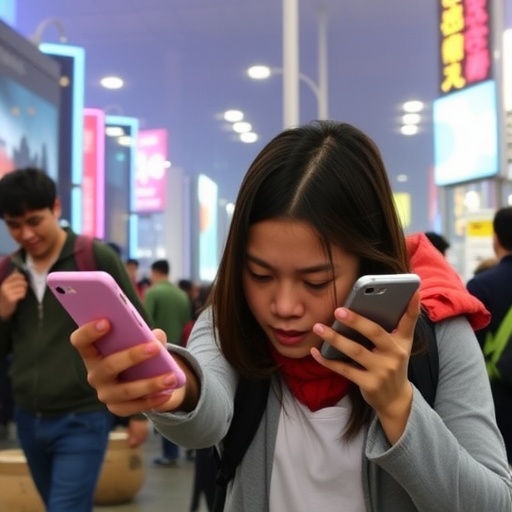The rapid surge in mobile phone usage among adolescents worldwide has propelled mobile phone dependence into the spotlight as a pressing public health issue. A recent groundbreaking study sheds light on this phenomenon by exploring the Mobile Phone Dependence Questionnaire (MPDQ) and its applicability across culturally distinct regions: mainland China and Hong Kong. This research makes a pivotal contribution to understanding how dependence on mobile phones manifests among youth in these settings, revealing both shared patterns and unique cultural intricacies.
Mobile phone dependence (MPD), often correlated with addictive behaviors, has gained attention due to its impact on adolescent mental health, academic performance, and social functioning. However, studying MPD across different populations necessitates tools that maintain reliability and validity despite cultural variations. The MPDQ, originally validated among Hong Kong adolescents, offers a nuanced approach by measuring multiple dimensions of phone-related dependence. This study rigorously assesses whether the MPDQ’s structure and metrics hold consistent when used with mainland Chinese adolescents.
Involving 918 middle school students with balanced gender representation, the research strategically sampled youth from both Shenzhen schools in mainland China and schools in Hong Kong. The average participant age was approximately 13.6 years, an important developmental period characterized by increasing autonomy and technological engagement. Through advanced statistical methods including confirmatory factor analysis and multidimensional item response theory, the authors meticulously examined the MPDQ’s psychometric properties across these groups.
Confirmatory factor analysis affirmed that the MPDQ’s three-factor structure—previously established within Hong Kong populations—remained robust across cultural boundaries. This finding suggests that the fundamental components of mobile phone dependence are largely shared between mainland Chinese and Hong Kong adolescents. Such factors likely encapsulate dimensions like compulsive usage, withdrawal, and tolerance, although the specific subscales were refined from prior research.
The study also conducted measurement invariance testing, a critical step in cross-cultural research ensuring that comparisons between groups are meaningful rather than artifacts of differing interpretation or response styles. Achieving configural, partial metric, and partial scalar invariance demonstrates a high degree of commonality in how adolescents from both regions perceive and respond to the MPDQ items. However, certain items required partial adjustments, hinting at subtle cultural nuances that could influence how dependence symptoms are expressed or reported.
Beyond establishing measurement equivalence, the research uncovered statistically significant differences in latent mean scores. Intriguingly, mainland Chinese adolescents reported higher overall levels of mobile phone dependence across all measured factors compared to their counterparts in Hong Kong. This outcome challenges prevailing assumptions, as Hong Kong’s technologically saturated environment might be expected to foster greater dependence. The result invites further investigation into environmental, social, and policy-related factors shaping adolescent mobile phone use.
Delving deeper into behavioral patterns, the study revealed that Hong Kong adolescents, while exhibiting lower overall MPD scores, displayed more pronounced disordered thoughts and behaviors associated with mobile phone dependence. This dual finding suggests that while mainland youth may use mobile phones more intensively or broadly, Hong Kong adolescents might experience more severe cognitive or emotional difficulties linked to their usage patterns. Such distinctions illuminate the complexity of dependence, emphasizing qualitative differences beyond mere usage frequency.
The implications of these findings are multifold. First, confirming the cross-cultural validity of the MPDQ facilitates its broader deployment in research and clinical settings, enabling more accurate identification and monitoring of mobile phone dependence among diverse adolescent populations. Second, recognizing culturally specific item sensitivities encourages ongoing refinement of assessment tools to better capture regionally relevant expressions of dependence.
Moreover, this research underscores the importance of culturally informed interventions. Tailoring prevention and treatment programs to address the distinct profiles of MPD found in mainland China and Hong Kong may enhance efficacy. For instance, interventions for mainland adolescents might prioritize reducing overall usage intensity, whereas those for Hong Kong youth could focus more on cognitive-behavioral strategies addressing dysfunctional thoughts and emotional regulation linked to mobile phone use.
This study also contributes to the broader discourse on digital health disparities. As mobile phone penetration continues to rise globally, understanding how dependence develops within different sociocultural contexts is paramount. The interplay between technology accessibility, normative practices, family dynamics, and educational policies all warrant deeper exploration to fully grasp the drivers behind MPD variability observed here.
The comprehensive methodological approach employed—including confirmatory factor analysis, measurement invariance testing, latent mean comparison, and advanced item response theory modeling—ensures robust and nuanced insights. Such rigor not only advances psychometric science but also sets a benchmark for future cross-cultural validation efforts in behavioral health assessments.
Ultimately, the study invites ongoing surveillance of adolescent mobile phone dependence, particularly in rapidly evolving technological landscapes like East Asia. It highlights that while technology pervades youth culture globally, the psychological and behavioral impact of such ubiquity is filtered through culturally specific lenses, shaping the lived experience of dependence.
As policymakers, educators, and mental health professionals grapple with the challenges posed by mobile phone dependence, validated and culturally sensitive measurement instruments like the MPDQ will be indispensable. They empower stakeholders to design targeted strategies, allocate resources effectively, and monitor intervention outcomes with precision.
In conclusion, this research marks a significant milestone in cross-cultural behavioral health measurement, illuminating the complex terrain of mobile phone dependence among adolescents in mainland China and Hong Kong. By bridging cultural divides through rigorous psychometric validation, the study opens pathways for more nuanced understanding and responsive action to mitigate the growing public health concern posed by mobile phone dependence worldwide.
Subject of Research: Measurement invariance and cross-cultural comparison of mobile phone dependence among adolescents in mainland China and Hong Kong.
Article Title: Measurement invariance and comparison of the mobile phone dependence questionnaire (MPDQ) across mainland Chinese and Hong Kong adolescents.
Article References:
Wang, H., Chin, F. & Chen, C. Measurement invariance and comparison of the mobile phone dependence questionnaire (MPDQ) across mainland Chinese and Hong Kong adolescents. BMC Psychiatry 25, 575 (2025). https://doi.org/10.1186/s12888-025-07057-y
Image Credits: AI Generated




